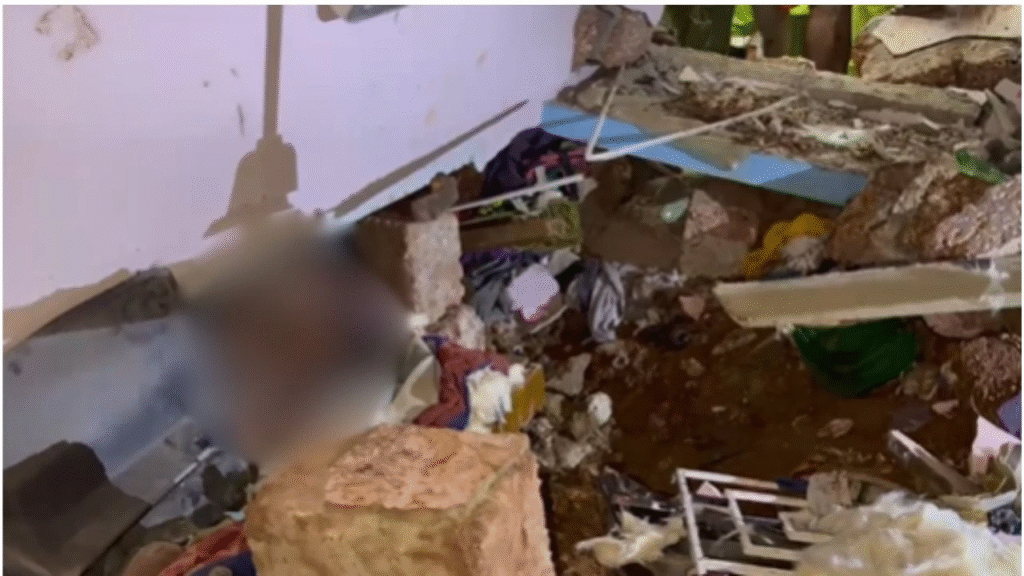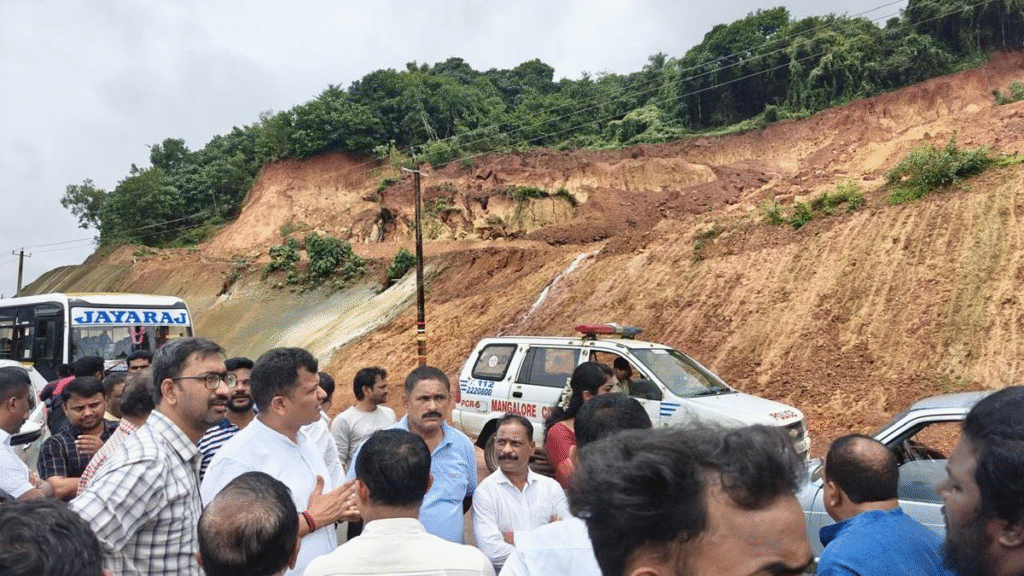
In the early hours of a seemingly ordinary day in Mangaluru, a sudden and catastrophic landslide changed countless lives forever. What started as a routine morning in this coastal city soon turned into a scene of devastation and despair. Homes that once stood proudly on the hillsides were swallowed by the earth. Families were torn apart, survivors left grappling with trauma, and the community plunged into mourning. Yet amid the rubble and grief, a storm of a different kind began to gather—a storm of accusations and demands for accountability.
This tragic landslide was not just a natural calamity; it has now become the center of a controversy highlighting alleged negligence by local authorities. The kin of victims have lodged a formal complaint, asserting that warnings about the unstable terrain were repeatedly ignored, and critical preventive measures were never implemented. This unfolding story is a poignant reminder of the fragile balance between human habitation and nature, and the heavy cost when that balance is disregarded.
The Morning the Hills Collapsed
Mangaluru, known for its scenic beauty and lush landscapes, faced one of its darkest moments when a large section of a hillside gave way. The landslide occurred in the outskirts, a region where residential areas and nature intertwine. In a terrifying instant, the hillside crumbled, sending tons of earth, rocks, and debris crashing down on homes nestled below.
Eyewitnesses recall the ground trembling and a deafening roar as the earth slid. Many were jolted awake by the chaos, scrambling to escape the deluge. Some were caught unaware, trapped beneath the rubble. The response was immediate — emergency personnel rushed to the scene, battling unstable terrain and continuous rain to search for survivors.
The affected area was home to several families, many of whom had lived there for generations. For these residents, the hillside was more than just land—it was their heritage and sanctuary. Now, it lay broken and hostile. Survivors spoke of frantic efforts to rescue loved ones, while others mourned those who did not survive.
Voices from the Ruins: Survivor Stories and Community Impact
Among the survivors is Meera, a mother who lost her home and two siblings in the disaster. Her voice, though trembling, carries the weight of loss and resilience. “I heard a loud rumble and felt the earth move beneath my feet,” she recalls. “We barely escaped. But many were not so lucky. The silence after was unbearable.”
Stories like Meera’s ripple throughout the community. Neighbors band together to provide shelter, food, and emotional support. The grief is collective, yet so is the determination to rebuild. Children who witnessed the collapse are now being comforted by relatives, their innocence forever touched by trauma.
Local schools and hospitals have mobilized to offer counseling and medical aid. However, the physical destruction is matched by the emotional and psychological scars left behind. Community leaders stress the need for long-term support as families navigate this tragedy.
Warnings Ignored: Allegations of Official Negligence
While the immediate concern was rescue and relief, a more troubling narrative soon emerged. Families of the victims have accused local officials of negligence, asserting that the landslide was preventable. According to their complaint, warnings about the hillside’s instability were brought to authorities’ attention multiple times, but no meaningful action was taken.
Residents say that cracks and minor landslides had appeared in the weeks preceding the disaster, signs that should have triggered preventive measures. “We alerted the officials, but the response was slow or nonexistent,” a community spokesperson stated. This sense of abandonment has fueled anger and calls for justice.
The complaint goes further, alleging that rapid construction without proper environmental assessment contributed to soil destabilization. The lack of adequate drainage systems and slope reinforcement are cited as critical oversights. Experts agree that such factors increase landslide risk, especially during the monsoon season.
Expert Insights: Understanding the Causes of the Landslide
To comprehend the gravity of the situation, it is essential to understand the science behind landslides in the region. Mangaluru’s terrain, characterized by hilly areas with loose soil and heavy rainfall during monsoons, is inherently vulnerable to slope failures.
Dr. Anil Kumar, a geologist specializing in landslides, explains, “The removal of natural vegetation, often due to construction, disrupts the soil’s stability. Roots bind the soil, and their absence can cause loose soil to give way when saturated by rain.” According to him, this landslide was likely triggered by a combination of natural and human-induced factors.
Environmental experts emphasize the importance of conducting thorough geotechnical assessments before approving any construction on hillsides. Additionally, installing drainage channels and retaining walls can mitigate the risk by managing water flow and reinforcing soil stability.
The Role of Urban Development and Planning
Mangaluru’s expanding urban footprint poses serious challenges to sustainable development. The demand for housing and infrastructure has pushed construction into areas traditionally considered risky. Often, these developments occur without stringent adherence to environmental regulations.
Urban planners warn that unchecked construction can exacerbate natural hazards. “Developers sometimes prioritize speed and profit over safety,” notes urban development consultant Ramesh Shetty. “This puts communities at risk.”

The landslide tragedy underscores the urgent need for policy reforms and stricter enforcement of building codes. Advocates call for integrating disaster risk assessments into city planning and promoting green infrastructure that works with the natural landscape rather than against it.
Government Response and Public Reaction
Facing mounting public outrage, district officials have pledged a thorough investigation into the landslide and the allegations of negligence. A committee has been formed to examine the sequence of events leading up to the disaster and to hold those responsible accountable.
Compensation for victims’ families has been announced, with monetary aid and promises of rehabilitation. However, many affected individuals question whether financial support can compensate for their loss. “No amount of money can bring back my family,” said a grieving relative at a recent press briefing.
The government’s response has been met with both cautious hope and skepticism. Critics point to a history of delayed action and lack of transparency in disaster management. Calls for improved disaster preparedness and infrastructure resilience have grown louder.
Community Solidarity and the Road to Recovery
Amid the sorrow, the spirit of community shines through. Relief camps have been established, where displaced families find shelter and support. Volunteers, NGOs, and local organizations have mobilized resources, distributing essentials and providing medical aid.
Neighbors have opened their homes to those who lost everything. Local schools have become centers for relief coordination. The community’s collective strength offers a glimmer of hope in dark times.
Rebuilding efforts are already underway, but residents stress the importance of not just reconstructing structures but restoring trust and safety. “We want to rebuild with care, ensuring this never happens again,” says a local community leader.
A Wake-Up Call for Sustainable Practices
The landslide has exposed glaring gaps in urban planning, environmental management, and disaster readiness. It serves as a harsh reminder of nature’s power and the consequences of human negligence. Sustainable development is not merely an ideal but a necessity.
Experts advocate for comprehensive risk mapping, public education on landslide warning signs, and collaboration between government, scientists, and communities. Early warning systems and real-time monitoring could save lives in future emergencies.
This tragedy could catalyze reforms that prioritize safety and environmental stewardship, transforming Mangaluru into a model for responsible urban growth.
The Quest for Justice and Accountability
For families who lost loved ones, the journey is far from over. The complaint filed against officials is not just about assigning blame but about demanding systemic change. Justice, they say, is crucial for healing.
Legal proceedings are expected to scrutinize the roles and responsibilities of various agencies involved. Transparency and accountability will be key to restoring public confidence.
“We owe it to the victims to ensure that negligence is never repeated,” states an advocate working with the affected families.
Conclusion: Lessons from Tragedy
The Mangaluru landslide tragedy is a somber chapter in the city’s history, marked by loss, resilience, and a fight for justice. It highlights the complex interplay between human ambition and environmental limits. While nature’s fury cannot always be controlled, human actions can mitigate risks.
As Mangaluru moves forward, the lessons learned must inspire change. Effective governance, community engagement, and respect for the environment are essential pillars of a safer future.
The stories of those who suffered remind us that behind every statistic is a human life deserving of dignity, care, and justice. Only through collective will and responsible action can the wounds of this disaster begin to heal.

